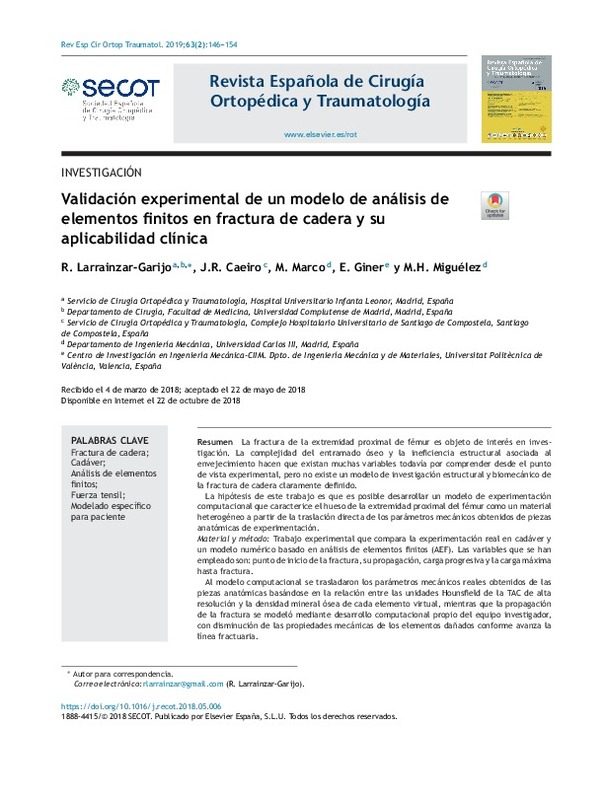Cristofolini, L., Juszczyk, M., Martelli, S., Taddei, F., & Viceconti, M. (2007). In vitro replication of spontaneous fractures of the proximal human femur. Journal of Biomechanics, 40(13), 2837-2845. doi:10.1016/j.jbiomech.2007.03.015
Santoni, B. G., Nayak, A. N., Cooper, S. A., Smithson, I. R., Cox, J. L., Marberry, S. T., & Sanders, R. W. (2016). Comparison of Femoral Head Rotation and Varus Collapse Between a Single Lag Screw and Integrated Dual Screw Intertrochanteric Hip Fracture Fixation Device Using a Cadaveric Hemi-Pelvis Biomechanical Model. Journal of Orthopaedic Trauma, 30(4), 164-169. doi:10.1097/bot.0000000000000552
Haynes, R. C., Pöll, R. G., Miles, A. W., & Weston, R. B. (1997). Failure of femoral head fixation: a cadaveric analysis of lag screw cut-out with the gamma locking nail and AO dynamic hip screw. Injury, 28(5-6), 337-341. doi:10.1016/s0020-1383(97)00035-1
[+]
Cristofolini, L., Juszczyk, M., Martelli, S., Taddei, F., & Viceconti, M. (2007). In vitro replication of spontaneous fractures of the proximal human femur. Journal of Biomechanics, 40(13), 2837-2845. doi:10.1016/j.jbiomech.2007.03.015
Santoni, B. G., Nayak, A. N., Cooper, S. A., Smithson, I. R., Cox, J. L., Marberry, S. T., & Sanders, R. W. (2016). Comparison of Femoral Head Rotation and Varus Collapse Between a Single Lag Screw and Integrated Dual Screw Intertrochanteric Hip Fracture Fixation Device Using a Cadaveric Hemi-Pelvis Biomechanical Model. Journal of Orthopaedic Trauma, 30(4), 164-169. doi:10.1097/bot.0000000000000552
Haynes, R. C., Pöll, R. G., Miles, A. W., & Weston, R. B. (1997). Failure of femoral head fixation: a cadaveric analysis of lag screw cut-out with the gamma locking nail and AO dynamic hip screw. Injury, 28(5-6), 337-341. doi:10.1016/s0020-1383(97)00035-1
Krischak, G. D., Augat, P., Beck, A., Arand, M., Baier, B., Blakytny, R., … Claes, L. (2007). Biomechanical comparison of two side plate fixation techniques in an unstable intertrochanteric osteotomy model: Sliding Hip Screw and Percutaneous Compression Plate. Clinical Biomechanics, 22(10), 1112-1118. doi:10.1016/j.clinbiomech.2007.07.016
Basso, T., Klaksvik, J., Syversen, U., & Foss, O. A. (2014). A biomechanical comparison of composite femurs and cadaver femurs used in experiments on operated hip fractures. Journal of Biomechanics, 47(16), 3898-3902. doi:10.1016/j.jbiomech.2014.10.025
Loh, B. W., Stokes, C. M., Miller, B. G., & Page, R. S. (2015). Femoroacetabular impingement osteoplasty. The Bone & Joint Journal, 97-B(9), 1214-1219. doi:10.1302/0301-620x.97b9.35263
Tsai, A. G., Reich, M. S., Bensusan, J., Ashworth, T., Marcus, R. E., & Akkus, O. (2013). A fatigue loading model for investigation of iatrogenic subtrochanteric fractures of the femur. Clinical Biomechanics, 28(9-10), 981-987. doi:10.1016/j.clinbiomech.2013.09.009
Knobe, M., Altgassen, S., Maier, K.-J., Gradl-Dietsch, G., Kaczmarek, C., Nebelung, S., … Buecking, B. (2017). Screw-blade fixation systems in Pauwels three femoral neck fractures: a biomechanical evaluation. International Orthopaedics, 42(2), 409-418. doi:10.1007/s00264-017-3587-y
García-Aznar, J. M., Bayod, J., Rosas, A., Larrainzar, R., García-Bógalo, R., Doblaré, M., & Llanos, L. F. (2008). Load Transfer Mechanism for Different Metatarsal Geometries: A Finite Element Study. Journal of Biomechanical Engineering, 131(2). doi:10.1115/1.3005174
Cilla, M., Checa, S., Preininger, B., Winkler, T., Perka, C., Duda, G. N., & Pumberger, M. (2017). Femoral head necrosis: A finite element analysis of common and novel surgical techniques. Clinical Biomechanics, 48, 49-56. doi:10.1016/j.clinbiomech.2017.07.005
Schileo, E., Taddei, F., Cristofolini, L., & Viceconti, M. (2008). Subject-specific finite element models implementing a maximum principal strain criterion are able to estimate failure risk and fracture location on human femurs tested in vitro. Journal of Biomechanics, 41(2), 356-367. doi:10.1016/j.jbiomech.2007.09.009
Giner, E., Arango, C., Vercher, A., & Javier Fuenmayor, F. (2014). Numerical modelling of the mechanical behaviour of an osteon with microcracks. Journal of the Mechanical Behavior of Biomedical Materials, 37, 109-124. doi:10.1016/j.jmbbm.2014.05.006
Morgan, E. F., & Keaveny, T. M. (2001). Dependence of yield strain of human trabecular bone on anatomic site. Journal of Biomechanics, 34(5), 569-577. doi:10.1016/s0021-9290(01)00011-2
Go´mez-Benito, M. J., Garcı´a-Aznar, J. M., & Doblare´, M. (2005). Finite Element Prediction of Proximal Femoral Fracture Patterns Under Different Loads. Journal of Biomechanical Engineering, 127(1), 9-14. doi:10.1115/1.1835347
Dragomir-Daescu, D., Salas, C., Uthamaraj, S., & Rossman, T. (2015). Quantitative computed tomography-based finite element analysis predictions of femoral strength and stiffness depend on computed tomography settings. Journal of Biomechanics, 48(1), 153-161. doi:10.1016/j.jbiomech.2014.09.016
Rezaei, A., Giambini, H., Rossman, T., Carlson, K. D., Yaszemski, M. J., Lu, L., & Dragomir-Daescu, D. (2017). Are DXA/aBMD and QCT/FEA Stiffness and Strength Estimates Sensitive to Sex and Age? Annals of Biomedical Engineering, 45(12), 2847-2856. doi:10.1007/s10439-017-1914-5
Khoo, B. C. C., Brown, K., Cann, C., Zhu, K., Henzell, S., Low, V., … Prince, R. L. (2008). Comparison of QCT-derived and DXA-derived areal bone mineral density and T scores. Osteoporosis International, 20(9), 1539-1545. doi:10.1007/s00198-008-0820-y
Khoo, B. C. C., Brown, K., Zhu, K., Pollock, M., Wilson, K. E., Price, R. I., & Prince, R. L. (2011). Differences in structural geometrical outcomes at the neck of the proximal femur using two-dimensional DXA-derived projection (APEX) and three-dimensional QCT-derived (BIT QCT) techniques. Osteoporosis International, 23(4), 1393-1398. doi:10.1007/s00198-011-1727-6
Dall’Ara, E., Eastell, R., Viceconti, M., Pahr, D., & Yang, L. (2016). Experimental validation of DXA-based finite element models for prediction of femoral strength. Journal of the Mechanical Behavior of Biomedical Materials, 63, 17-25. doi:10.1016/j.jmbbm.2016.06.004
LOUBONNICK, S. (2007). HSA: Beyond BMD with DXA. Bone, 41(1), S9-S12. doi:10.1016/j.bone.2007.03.007
Marco, M., Larraínzar, R., Giner, E., Caeiro, J. R., & Miguélez, H. (2016). Análisis de la variación del comportamiento mecánico de la extremidad proximal del fémur mediante el método XFEM (eXtended Finite Element Method). Revista de Osteoporosis y Metabolismo Mineral, 8(2), 61-69. doi:10.4321/s1889-836x2016000200003
Lenich, A., Bachmeier, S., Prantl, L., Nerlich, M., Hammer, J., Mayr, E., … Füchtmeier, B. (2011). Is the rotation of the femural head a potential initiation for cutting out? A theoretical and experimental approach. BMC Musculoskeletal Disorders, 12(1). doi:10.1186/1471-2474-12-79
Kurz, S., Pieroh, P., Lenk, M., Josten, C., & Böhme, J. (2017). Three-dimensional reduction and finite element analysis improves the treatment of pelvic malunion reconstructive surgery. Medicine, 96(42), e8136. doi:10.1097/md.0000000000008136
Vercher, A., Giner, E., Arango, C., Tarancón, J. E., & Fuenmayor, F. J. (2013). Homogenized stiffness matrices for mineralized collagen fibrils and lamellar bone using unit cell finite element models. Biomechanics and Modeling in Mechanobiology, 13(2), 437-449. doi:10.1007/s10237-013-0507-y
[-]










